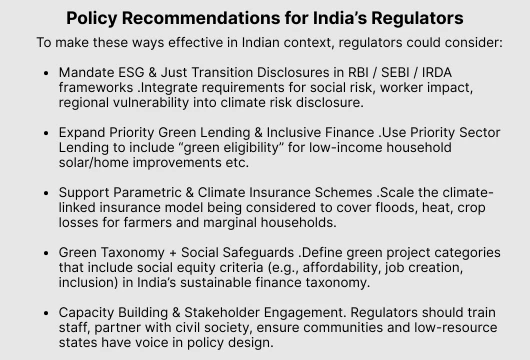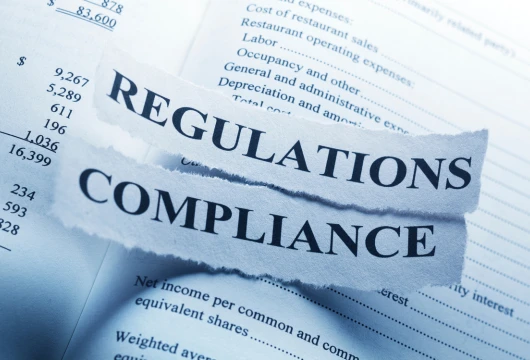How Financial Regulators Can Drive Fair, Inclusive Climate Regulation & Climate Action
As the urgency of climate change intensifies, financial regulators are being asked not just to facilitate sustainable finance, but to ensure that climate action also advances social equity. That means policies must protect vulnerable populations, produce shared benefits, and prevent undue burdens on low-income or marginalized communities.
India, with its large informal economy, rural populations, and socio-economic disparities, stands to gain much from regulatory frameworks that combine climate legitimacy with equity. But balancing these two demands is complex. In this article, we examine three actionable ways regulators—central banks, securities regulators, insurance regulators—can align climate action with social equity. We also consider examples, challenges, and what is needed for implementation in Indian context.
Way 1: Inclusive Green Finance Policies & Financial Product Regulation
What it Means
Inclusive Green Finance (IGF) refers to regulatory policies and frameworks that ensure green financial products and access to sustainable finance reach vulnerable, low-income, rural, and marginalized populations—not just large corporates or wealthy investors. This involves designing regulations that encourage financial inclusion while mandating environmental performance.

Key Tools for Regulators
Support for Parametric Insurance & Risk-Sharing Mechanisms
Regulators can approve and promote insurance schemes that pay out quickly in climate disasters (floods, droughts, heatwaves) using trigger-based models. That reduces delays and helps poor communities recover quickly.
Green Credit/Product Mandates with Equity Components
Require banks and other financial institutions to offer “green credit” or green-loan programs targeted at small and marginal farmers, low-income households, or MSMEs (micro, small, medium enterprises), with subsidized interest or concessional terms.
Require Disclosure of Environmental & Social Risk
Ensure financial institutions disclose not just environmental risks in their portfolios, but also social impacts—how climate policies might affect jobs, incomes, communities. This helps avoid burdens on vulnerable groups.
Examples & Case Studies
- Alliance for Financial Inclusion (AFI) has worked with developing economy regulators to adopt IGF policies. For instance, Ecuador’s SEPS launched Environmental & Social Risk Management Guidelines to enable credit co-operatives to support low-carbon, resilient services for vulnerable communities.
- India’s Green Indian Financial System Initiative (Shakti Foundation, AFD, SIDBI) is building dialogue on green finance regulation, green taxonomy, and incorporating climate risk into oversight frameworks.
- The recent proposal in India for a nationwide climate-linked insurance scheme is an example where payouts tied to weather events aim to help those impacted by extreme weather. This regulatory innovation would reduce reliance on more general disaster relief which often lags significantly.
Equity Benefits
- Ensures access to sustainable energy, climate resilience even in poor households.
- Reduces loss of assets/income for climate-vulnerable groups (farmers, slum dwellers, coastal or floodplain populations).
- Helps spread benefits of green projects across society—jobs in local clean energy or adaptive agriculture.
Way 2: Just Transition Metrics and Regulatory Mandates
What it Means
“Just Transition” refers to ensuring the move away from fossil fuels and high-carbon industries doesn’t leave behind workers, regions or communities dependent on those sectors. Regulators can mandate disclosure, incentives, capital allocation, and policy design that account for the economic and social impact of transition.

Key Tools for Regulators
Mandating Just Transition Reporting / Metrics : Require regulated entities (banks, insurers, investment funds) to report not only greenhouse gas emissions risk but also metrics like job losses, geographic impact, worker reskilling, community welfare in affected regions.
Incentivizing Green Projects in Affected Regions : Provide policy incentives (lower capital charges, grants, subsidies, tax breaks) for green projects (renewables, sustainable agriculture, storage) to be located in regions transitioning away from coal, coal mines, or other high-carbon industries.
Reskilling & Worker Protection Built into Regulation : Financial regulators can require financing for green infrastructure to include components for reskilling workers from carbon-intensive industries or supporting economic diversification in those regions.
Examples & Indonesia / India Perspective
- In India, a recent report on Just Transition financing ecosystem emphasizes that regulators like SEBI and RBI could integrate JT metrics into disclosures, lending norms, and sustainable finance tools (e.g., sustainability-linked loans, Priority Sector Lending) to help communities dependent on fossil fuel sectors.
- Globally, the EU has set up the Just Transition Mechanism in its Green Deal to ensure financial support to coal region transitions, scaling new industries, retraining, and funding social programs. While India doesn’t have an identical mechanism, analogous regulatory tools could emulate this.
Equity Benefits
- Protects workers and communities from job losses, economic dislocation.
- Mitigates regional inequalities by channeling green investments to neglected regions.
- Encourages socially sustainable transition—reducing risk of protests, backlash.
Way 3: Regulatory Frameworks for Carbon Disclosure + Incentivizing Green & Responsible Investment
What it Means
Aligning climate action with social equity also means ensuring transparency in financed emissions and enabling investments that are both climate-aligned and socially beneficial. Regulators can set rules for disclosure, use green taxonomies, enforce ESG criteria, and incentivize sustainable bonds, loans, or securities that deliver social as well as environmental returns.

Key Tools for Regulators
Mandatory ESG / Climate Risk Disclosure : Require banks, asset managers, insurers to disclose climate risks and emissions in line with science-based standards. Also require social impact metrics—e.g. impacts on low-income communities, access to clean energy, employment, health outcomes.
Green or Sustainability-Linked Financial Products with Social Safeguards : Oversight of green bonds, social bonds, sustainability-linked loans or bonds must ensure that proceeds genuinely benefit climate and social goals (no “greenwashing”). Regulators can enforce use-of-proceeds rules, third-party auditing, certifications.
Priority Sector / Social Lending Requirements : Regulators (especially central banks) can expand or adapt priority sector lending programs to include green elements: e.g., loans for clean cookstoves, rooftop solar for low income households, climate resilient housing in slums, microfinance for eco-friendly agriculture practices.
Examples & Case Points
- SEBI’s efforts in India to expand sustainable finance frameworks in securities markets green bonds, sustainability-linked debt, etc.—implies regulatory push for responsible investment products. (One report/news item noted SEBI proposing “sustainable securitized debt instruments” among options.)
- The OECD’s report “Aligning Finance with Climate Goals” states that financial sector policies are increasingly integrating climate considerations as risks to stability, and that real-economy policies and financial regulation together are key.
- The Center for Sustainable Finance (CSF, India) works with regulators and financial institutions for policy inputs, capacity building, and frameworks to channel capital toward sustainable development with attention to risk and inclusion.
Equity Benefits
- Transparency helps communities know where environmental risks exist and can contest unjust impacts.
- Responsible investment tools ensure marginalized groups benefit from green finance rather than being excluded.
- Priority sector green finance ensures those with least resources get access to climate-friendly technologies (clean cookstoves, solar lighting, resilient housing)
Intersection: How These Three Ways Reinforce Each Other
These three strategies are not independent—they reinforce each other. For example:
- Inclusive green finance (Way 1) works better if disclosures and social metrics (Way 3) are present, to ensure accountability.
- Just transition metrics (Way 2) require financing tools and green products (Way 1 & 3) to support affected workers and communities.
- Combining regulatory mandates, disclosure, and social inclusion accelerates the shift toward green outcomes that are fair
Challenges & Trade-Offs
Regulators must navigate several challenges to make sure climate action doesn’t unintentionally worsen inequality:
- Data Gaps: Lack of good social/poverty/distributional data tied to climate risk.
- Capacity Constraints: Regulators need technical, legal, financial capacity—especially in emerging markets or states in India.
- Risk of Greenwashing: Without clear definitions and enforcement, “green” products may become marketing tools.
- Cost Burden on Consumers: Climate risk regulation could raise costs (e.g., cleaner technology, compliance) which may burden low-income households if not mitigated.
- Regional Disparities: Climate impacts differ across regions; regulatory frameworks must allow local tailoring.

Financial regulators play a critical role in ensuring that climate action is not just environmentally effective, but socially fair. By promoting inclusive green finance, enforcing just-transition mandates, and regulating investment products with transparency and social safeguards, regulators can help build resilient, equitable, and sustainable economies.
For India, combining these regulatory tools offers an opportunity to ensure that:
- Climate risks do not disproportionately harm vulnerable populations
- Green economy benefits (jobs, clean energy, resilient infrastructure) are broadly shared
- The transition supports both sustainability and social justice
As climate policy advances, aligning regulation with equity is not just moral—it’s essential for legitimacy, stability, and long-term growth.
For more inspiring Blogs, click here

